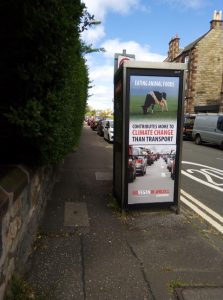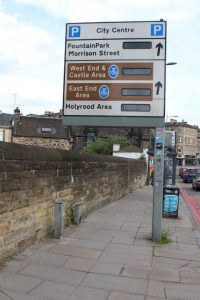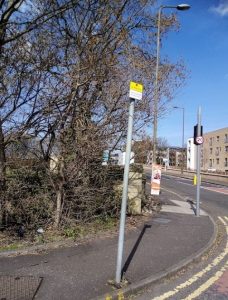Introduction
 The Living Streets Edinburgh Group (LSEG) carried out a project to tackle pavement clutter in the summer of 2019. We are grateful to Paths for All for supporting the project through its ‘Smarter Choices Smarter Places’ Open Fund.
The Living Streets Edinburgh Group (LSEG) carried out a project to tackle pavement clutter in the summer of 2019. We are grateful to Paths for All for supporting the project through its ‘Smarter Choices Smarter Places’ Open Fund.
The first objective of the project was to identify at least 100 obstructions on city pavements which inhibit walking – aiming to have at least some of these removed. Secondly, and just as important, we wanted to develop our understanding of the problems that street clutter cause and share perspectives on managing clutter between ourselves (LSEG members), community representatives and council staff working at ‘the coal face’ of managing local roads. This meant working closely with the four Locality Roads Managers across the city and their staff.
What we did
 Four members of LSEG participated in the project, each working in one of the four ‘Localities’ (North West, North East, South East and South West). We emailed all community councils in the city that we could find and also the Edinburgh Access Panel, inviting suggestions for areas to look at where ‘pavement clutter’ was seen as a problem.
Four members of LSEG participated in the project, each working in one of the four ‘Localities’ (North West, North East, South East and South West). We emailed all community councils in the city that we could find and also the Edinburgh Access Panel, inviting suggestions for areas to look at where ‘pavement clutter’ was seen as a problem.
Based on this feedback and personal knowledge, we then walked selected city streets, recording and photographing objects which we felt inhibited walking and should be removed. We appreciate the participation of members of the Access Panel, community councillors and City of Edinburgh Councillors who joined us on several of these walks.
The project aimed to take in different parts of the city, focussing as much on residential areas as on ‘town centres’ or central Edinburgh. The main areas assessed are set out below. We appreciate that this inevitably misses out many parts of the city where no doubt pavement clutter is just as much of a problem as in these areas.
| NW | SW | SE | NE |
| Blackhall/Craigleith | Colinton | Bruntsfield | Easter Road |
| Broomhouse | Dalry | Tollcross | Leith Walk |
| Corstorphine | Gorgie | Hanover St | London Road |
| Drumbrae | Oxgangs | Morrison St | Portobello |
| Ferry Road | Slateford | South Bridge | Willowbrae |
| Pilton | Walter Scott Avenue |
What did we find?

In all, we identified 290 items of ‘clutter’ which we felt should be tackled – far more than the original target of 100! We took a broad view of what might be considered ‘clutter’, which to some extent is subjective. However, we aimed to focus on things which are fixed, or at least in place for a considerable time. So this included things like signage poles, guard rails, large refuse bins, bushes, utility boxes, phone kiosks and roadworks signs. We generally excluded things like the occasional stray ‘A-board’ (contravening the council-wide ban), regular wheelie bins and pavement parking, despite encountering this on many streets.
At the time or writing, we are awaiting responses from the council on most of the items which we identified. However, few items have been tackled as ‘quick wins’ (especially removal of overhanging vegetation). In some other cases, council staff judge that items which we identified as ‘clutter’ should be retained. Often, locality staff have to consult further with colleagues over whether items which we have identified can be removed.
Lessons learned
LSEG developed a better understanding of how ‘clutter’ comes about and how difficult it can be for local roads staff to manage. There can be historic reasons to explain the presence of some clutter; for example a guardrail on St Johns Road used to provide protection at a busy bakery, but has long been closed. Local roads staff face requests for items to be placed on the street from many different sources (both within the council and from external bodies). Resource constraints (both in terms of staffing and capital) seem to limit the extent to which clutter (and the scope for removing it) is assessed. Another clear message is that inspection regimes are almost entirely focussed on hazards and ‘defects’ – for example a broken traffic sign will be reported, but not an unnecessary one.
The influence of the Council’s Street Design Guidance – which has minimising clutter as one of its key principles – seems limited in practice. A particular example of this is that, despite the Guidance stating that vertical No Loading signs should normally be removed, other council managers have advised locality staff that these signs should be kept.
In some cases, action to remove clutter may require a programmed, rather than-an-item by item, approach. Examples include obsolete (non-operational) ‘real-time’ parking availability signs and poorly maintained or semi-derelict phone boxes. There seems to be a real opportunity to manage streets more ‘holistically’ which should produce better streets; and perhaps also reduce costs.
Next steps
We believe that there are valuable insights from this project which will be useful to share with a wider audience – to community groups in Edinburgh, City of Edinburgh Council staff, other councils, and professional bodies and institutes. We therefore hope to secure additional funding to enable us to publish a professionally produced report and a short video to communicate the findings of our project more widely.
We will also keep in touch with the localities staff (currently being re-organised) and continue to monitor what happens to the 290 items we recorded. To keep in touch, please see our website and Twitter account for further updates.
David Hunter
Living Streets Edinburgh Group
October 2019